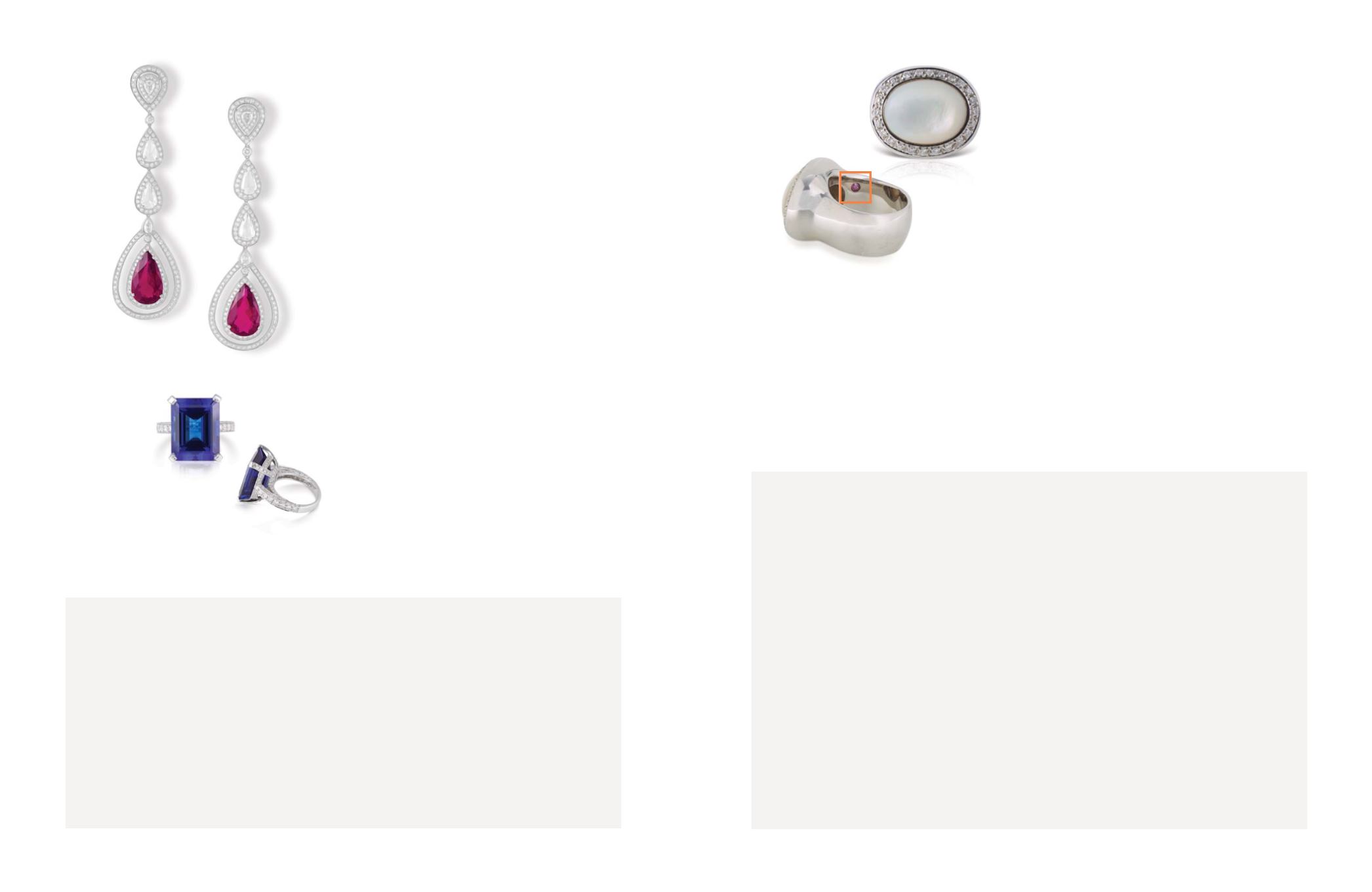

82
83
98
PAIR OF RUBELLITE TOURMALINE
AND DIAMOND EARRINGS
Each earring is composed of a drop‒shaped diamond‒
set open frame suspending a drop‒shaped rubellite
with a diamond‒set surround; to three similarly stylised
diamond‒set links, mounted in white gold.
Rubellite: 9.62 carats
Diamond: 6.05 carats
Gross weight: 21.84 grams
$ 8,930 ‒ 10,360
Rs 6,25,000 ‒ 7,25,000
99
TANZANITE AND DIAMOND RING
Rectangular tanzanite centred on a diamond‒set shank
in 18 K white gold. Stamped ‘750’.
Tanzanite: 21.88 carats
Diamond: 2.27 carats
Gross weight: 10 grams
$ 11,430 ‒ 14,290
Rs 8,00,000 ‒ 10,00,000
Ring size: American 6 3/4, English N
100
MOTHER‒OF‒PEARL AND DIAMOND
RING BY ROBERTO COIN
Centring on a mother‒of‒pearl cabochon surrounded
by full‒cut diamonds. The inside of the band is set with
a circular ruby. With maker’s marks and stamped ‘18K’.
Gross weight: 21.85 grams
$ 4,290 ‒ 5,715
Rs 3,00,000 ‒ 4,00,000
Due to export regulations, this lot cannot be sold
outside India
Ring size: American 6 3/4, English N
A
recent addition to the world of coloured stones, tanzanite was discovered in 1967 by a Masai
tribesman named Ali Juuyawatu, who came across a cluster of iridescent blue crystals in the
Merelani Hills of Tanzania. Initially mistaken for sapphires, their potential was soon recognised in
the international jewellery market. Tiffany’s struck a deal to become its main distributor, naming
the crystal “Tanzanite,” and Henry Platt, former president of Tiffany’s, stated that it was “the
most beautiful blue stone to be discovered in 2000 years.” Tanzanite, which is found only in the
city of Arusha in Tanzania, soon became a favourite with leading jewellery designers and gem
professionals. A variety of the mineral zoisite, in their natural state, tanzanite crystals radiate
three colours – blue, violet and brown; while the colours of polished and cut stones can range
from a light lilac to a deep indigo.
R
oberto Coin and his company are among the top designer jewellery brands in the world
today. After accomplishing a successful career as a hotelier at a young age, Coin decided
to pursue his desire to work in the fashion industry in the late 1970s. By 1984, Coin began
designing jewellery for other jewellers, and continued to do so for another decade. In 1996, Coin
inaugurated his own brand with the
Appassionata
collection, which was immediately popular
and internationally recognised. Within four years, he was ranked seventh in the United States
among the best jewellery designers. To distinguish himself from other jewellers, he formed
his unique trademark signature by setting a small ruby inside each of his jewelled creations,
which started with his debut collection and continues today.
This concept originated from his interest in history and mythology, which led to him to three
specific myths surrounding the red gemstone and convinced him to include it in his designs. The
first was an ancient Egyptian myth believed by the pharaohs who considered that the ruby, if
kept in contact with your skin, ensured love, happiness and health. The second story was of the
Burmese warriors who believed the ruby to be a protective talisman that made them invulnerable
on the battlefield. The third legend was from old Hindu folklore in which the mythical Kalpa
tree, which is composed entirely of precious stones, bore rubies as fruit. With the hidden ruby as
his signature, Coin initiates a symbolic gesture of goodwill and fortune—encompassing all three
legends and their mythical properties—to all those who wear his creations.


















